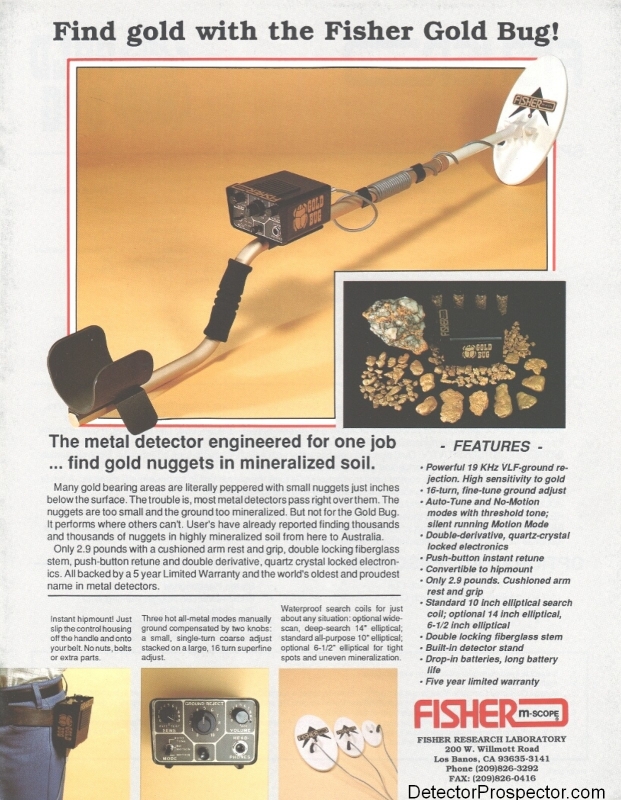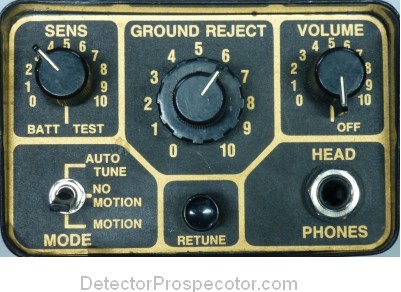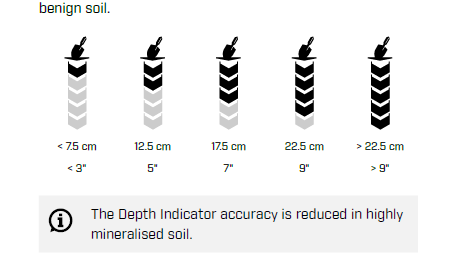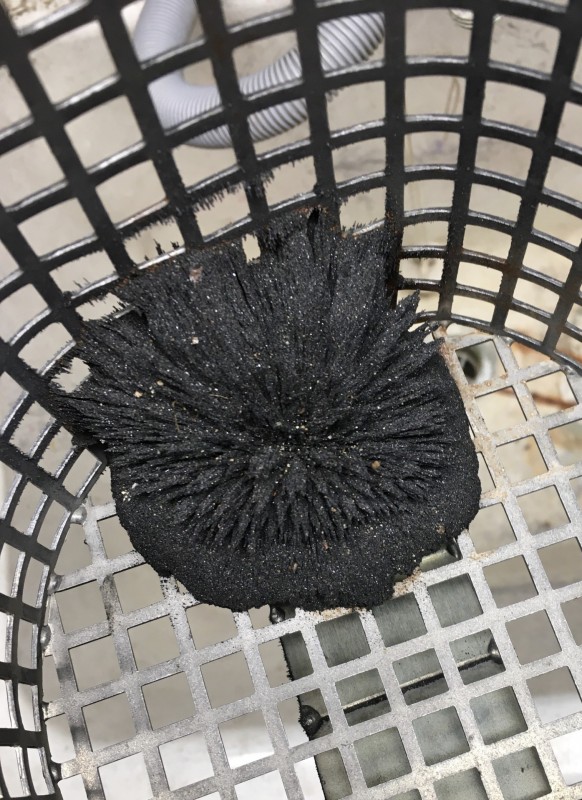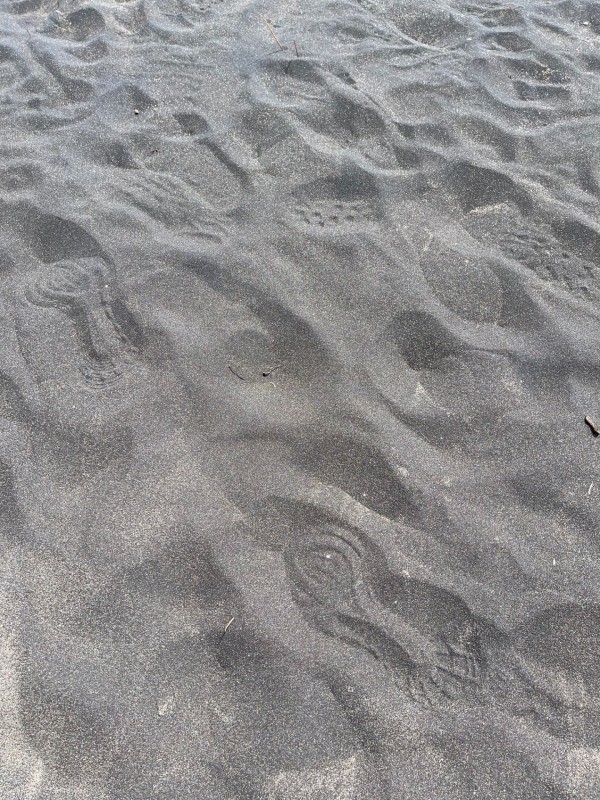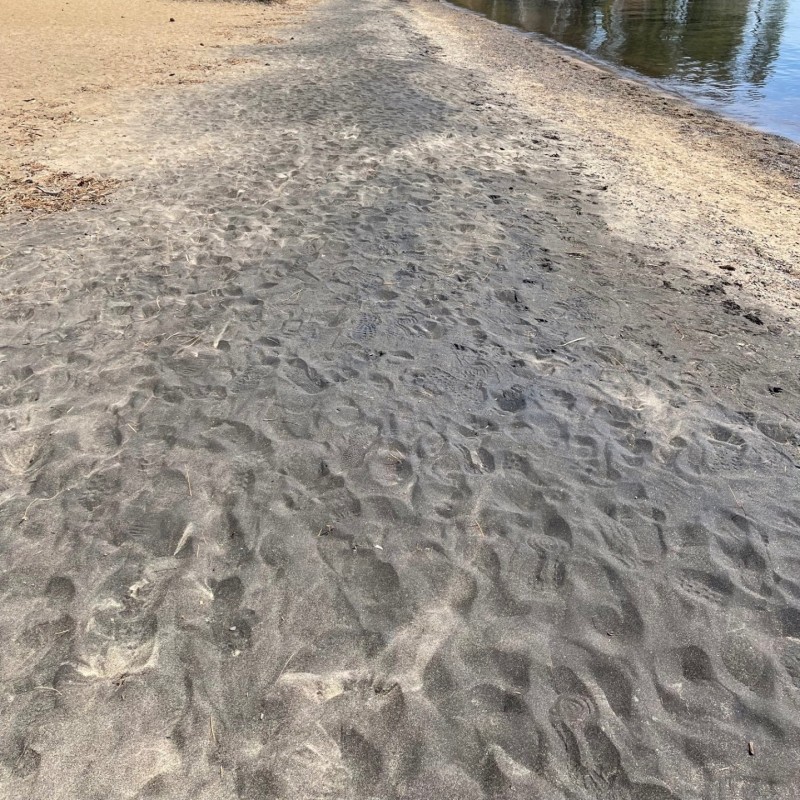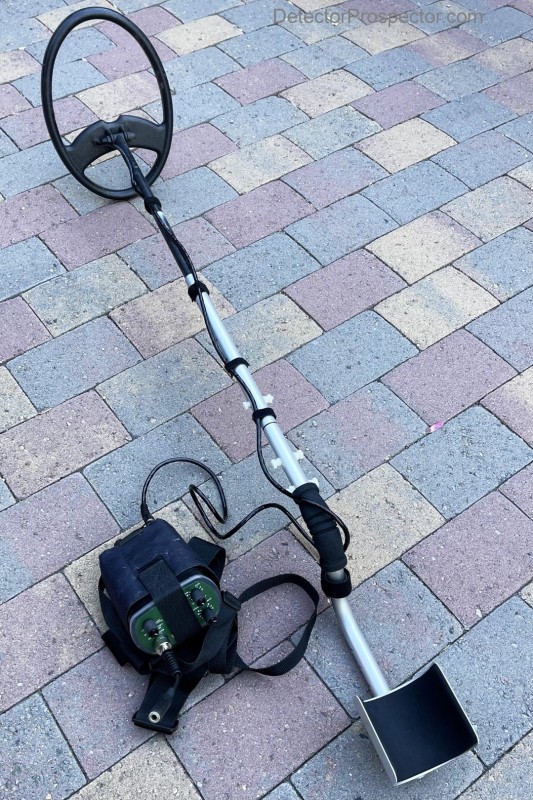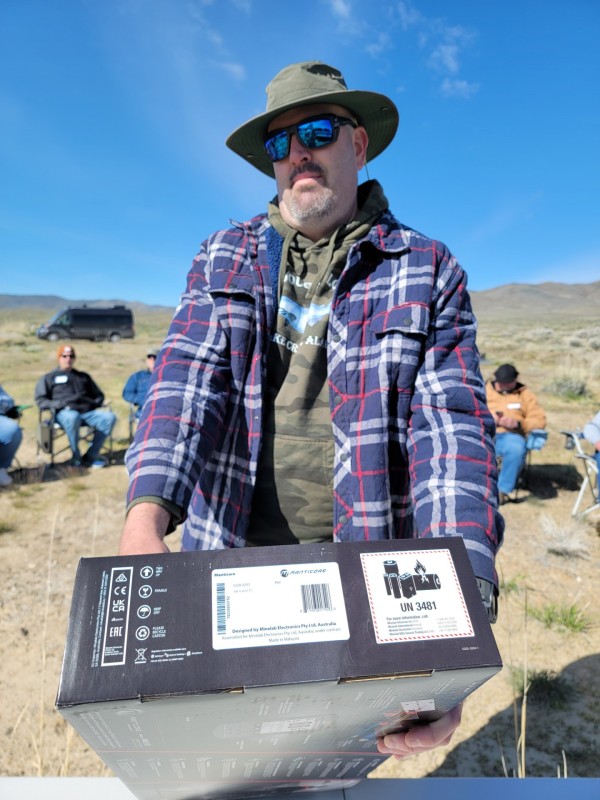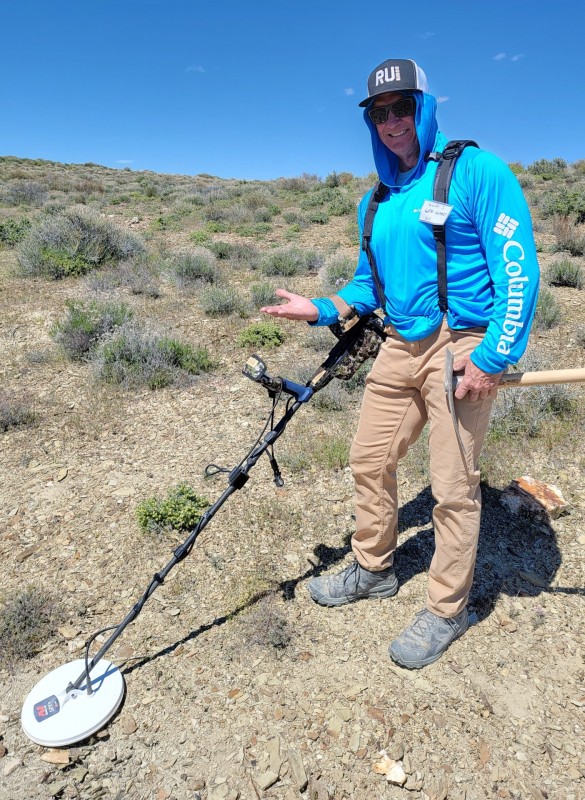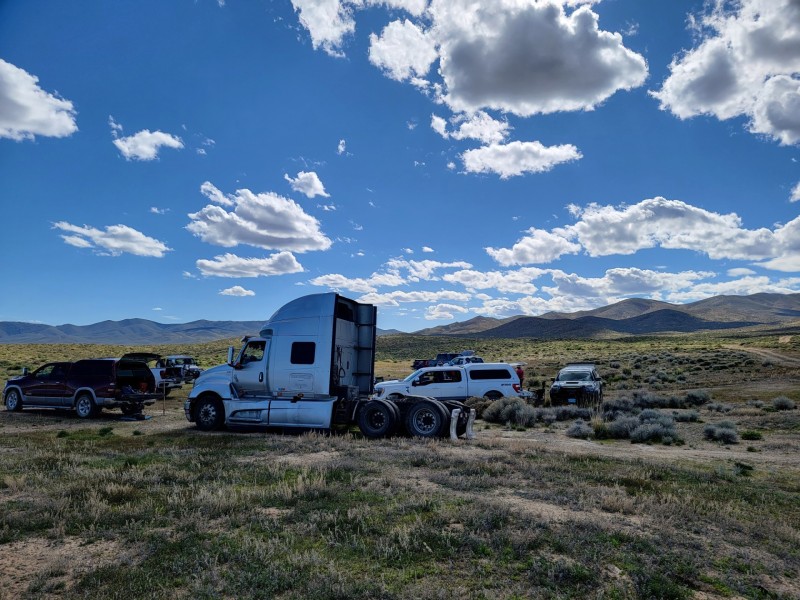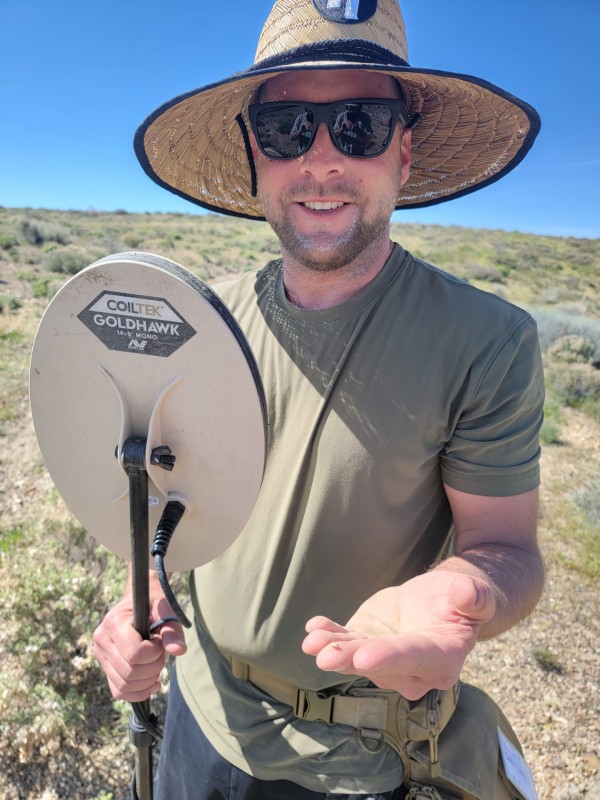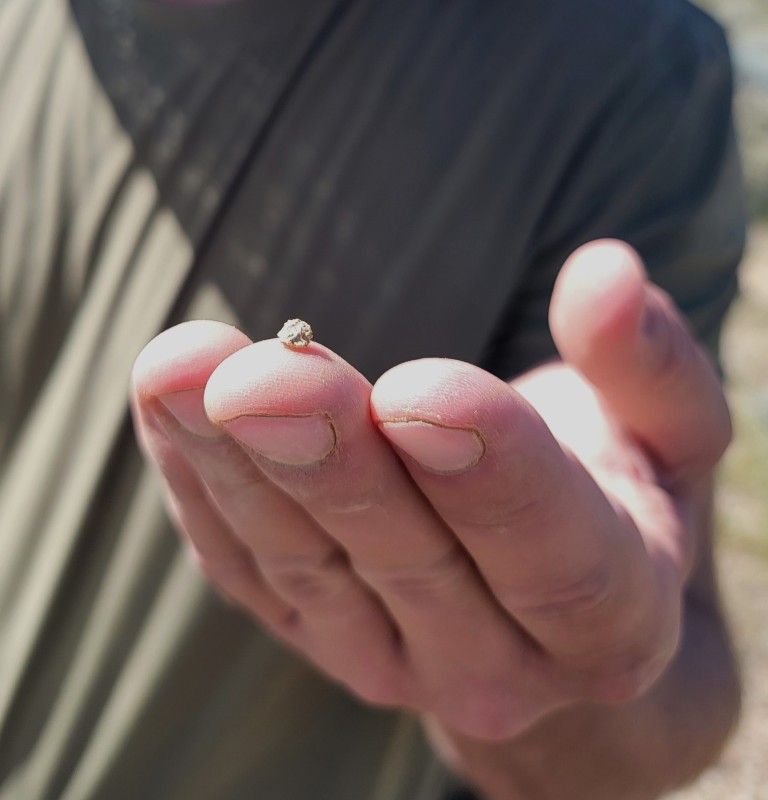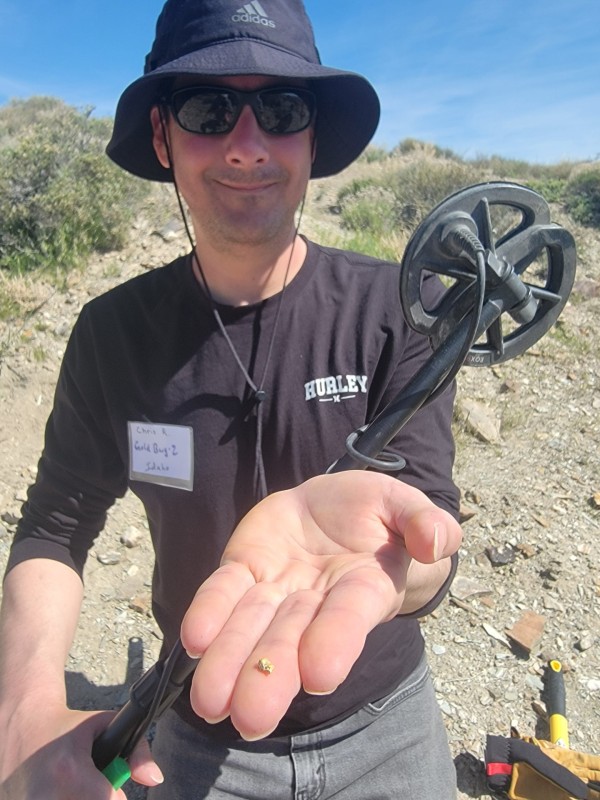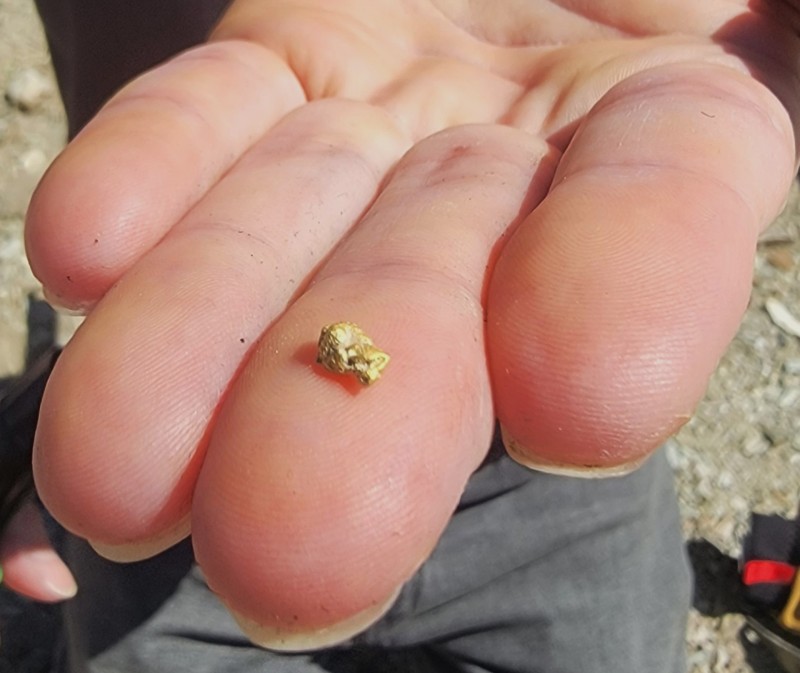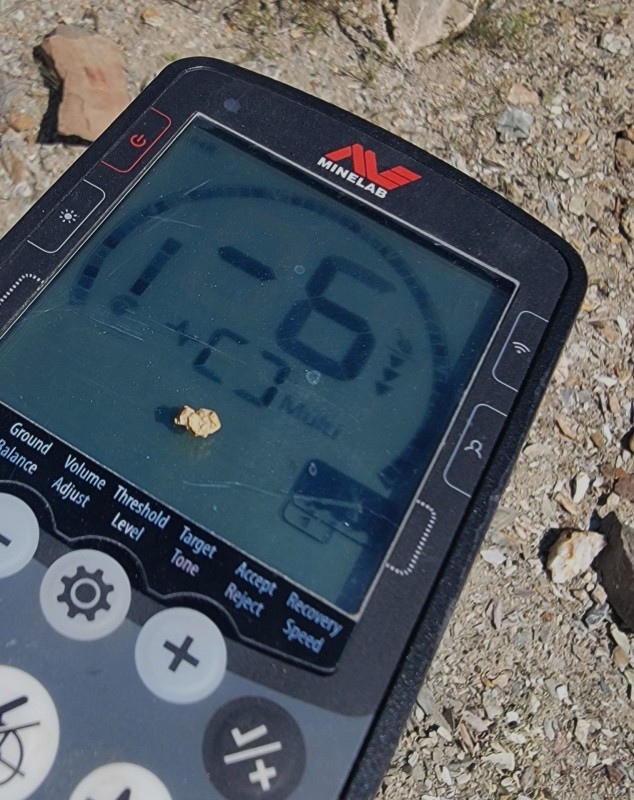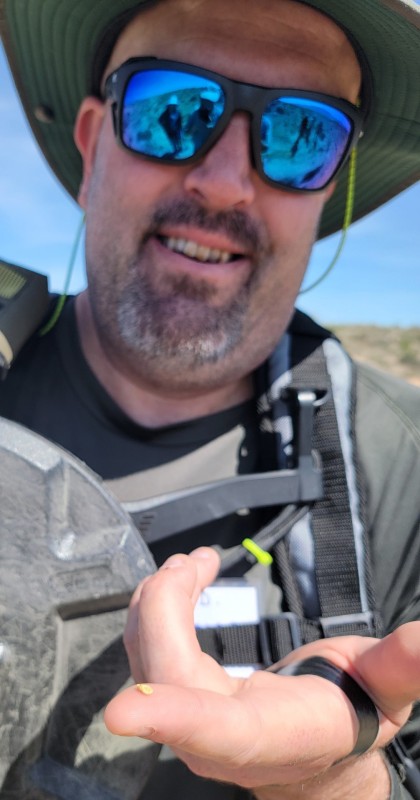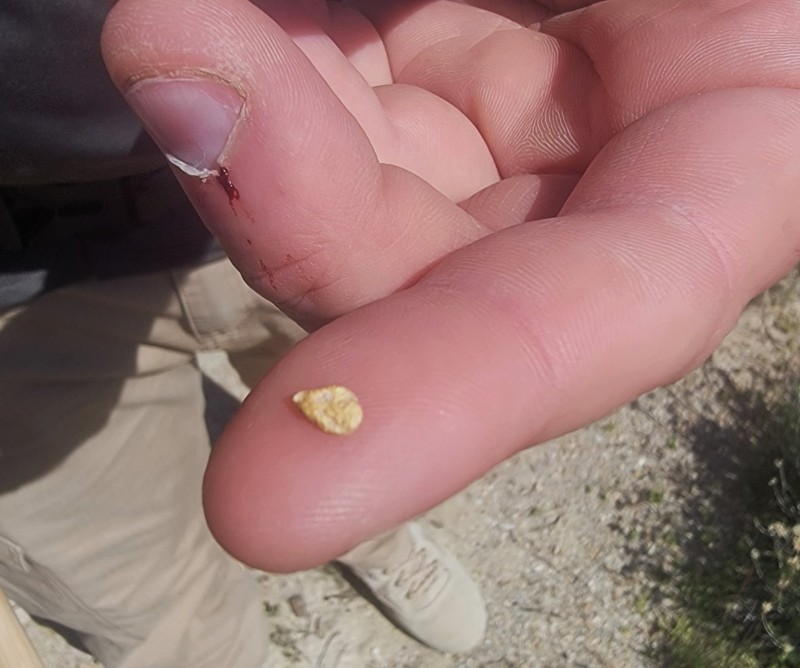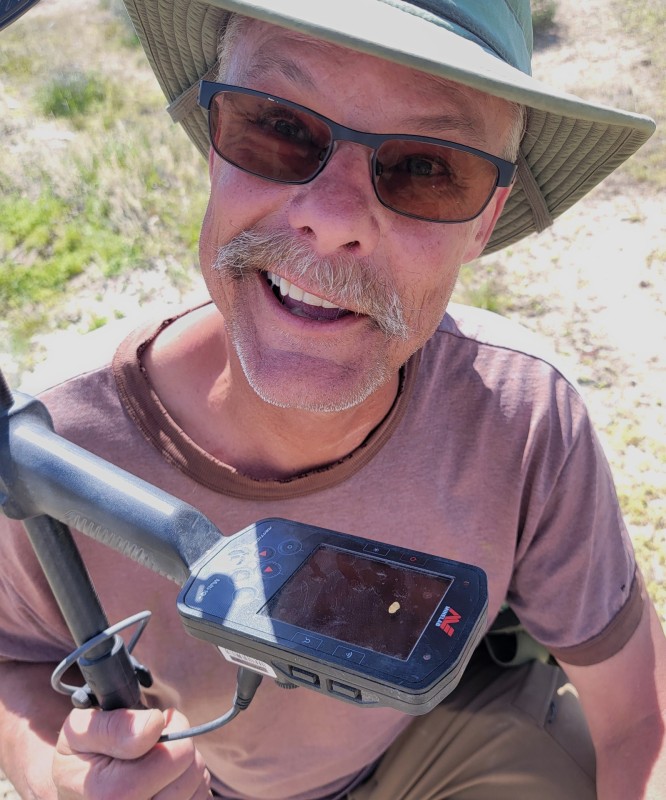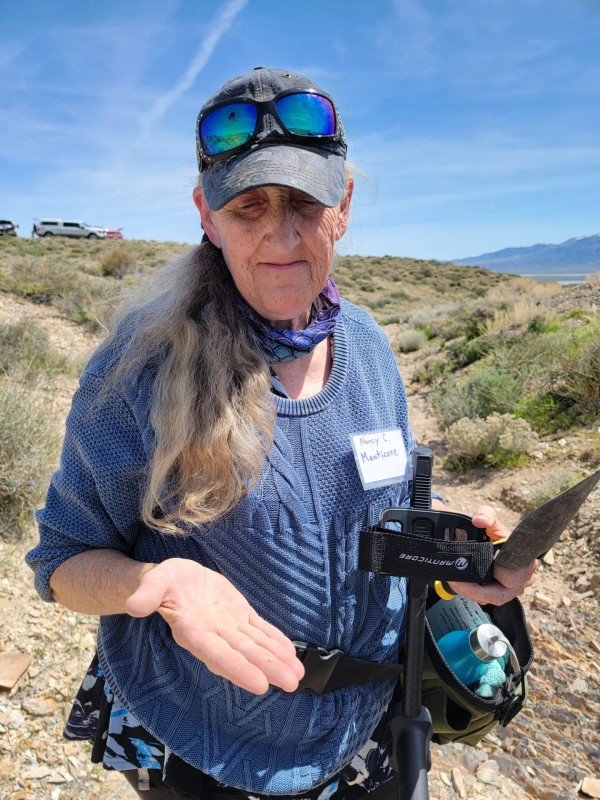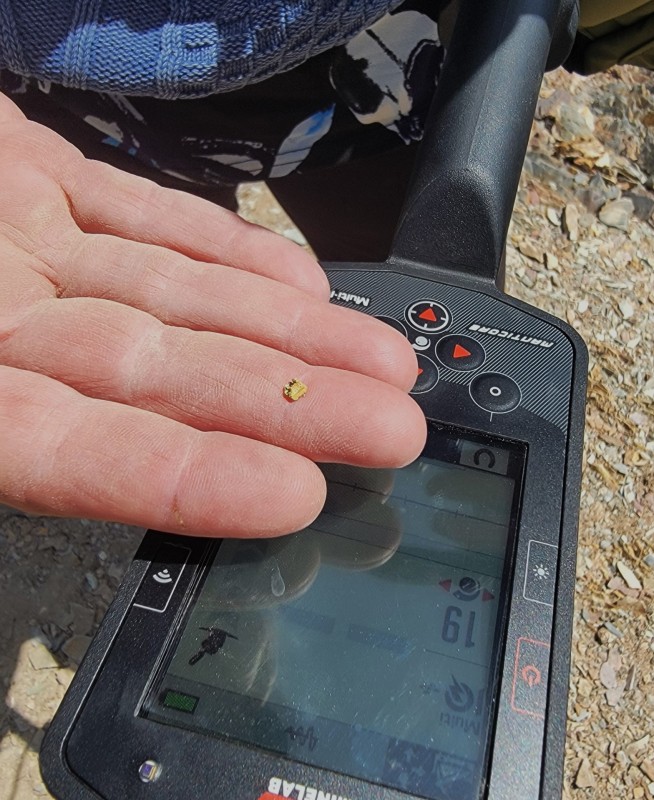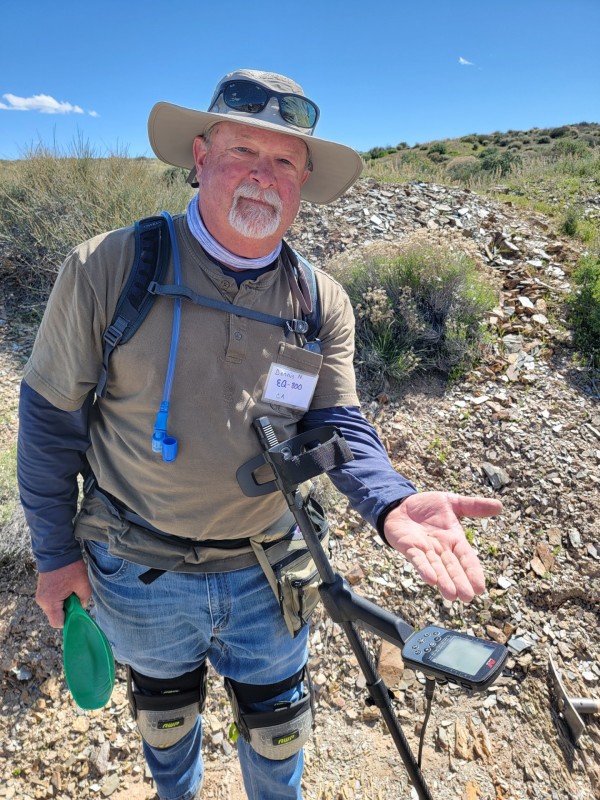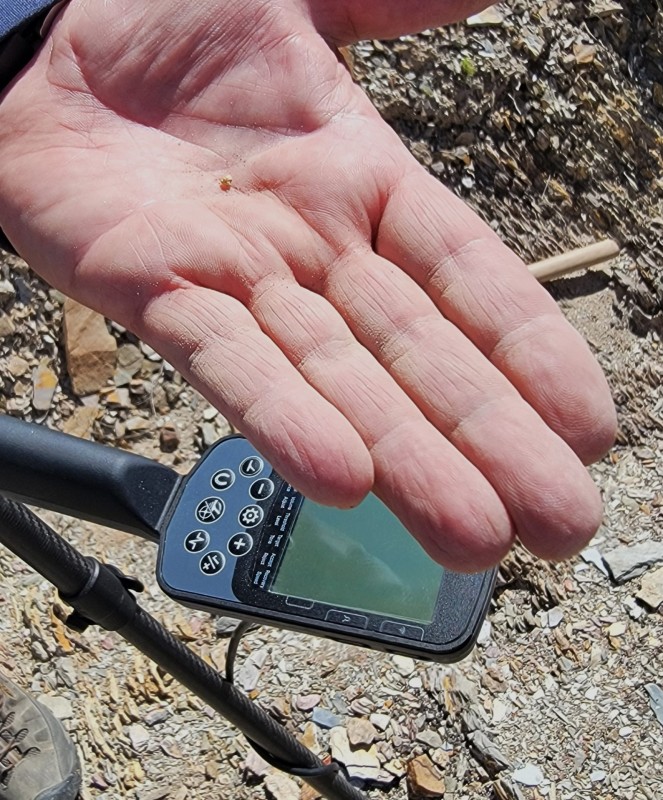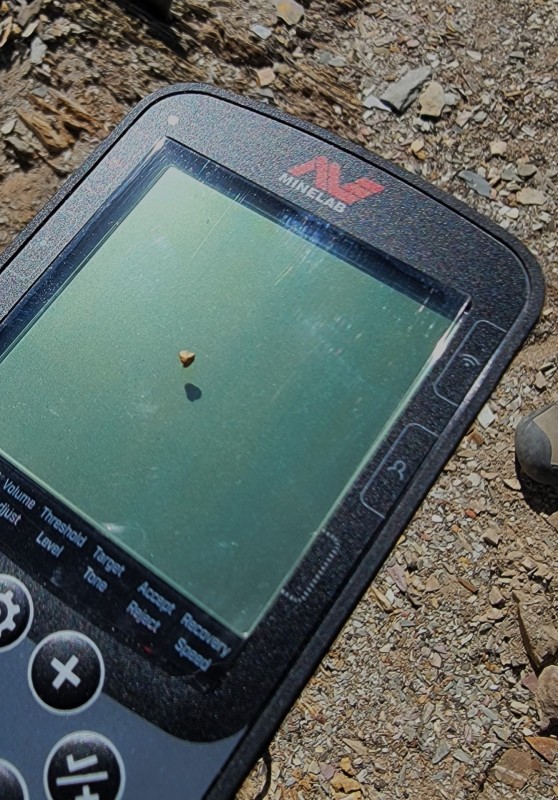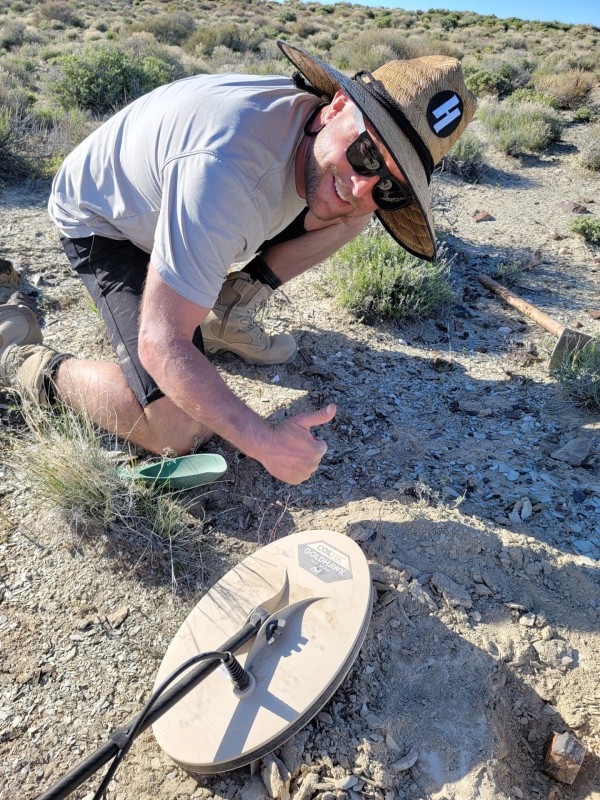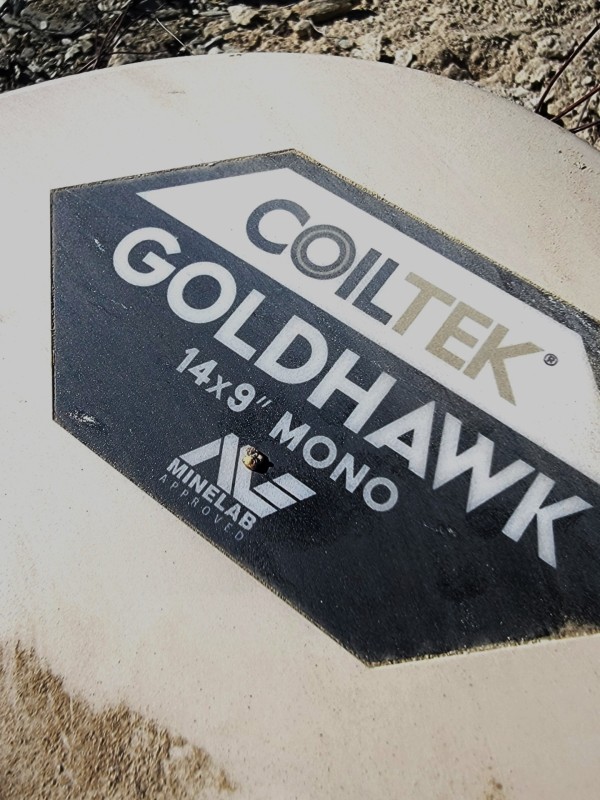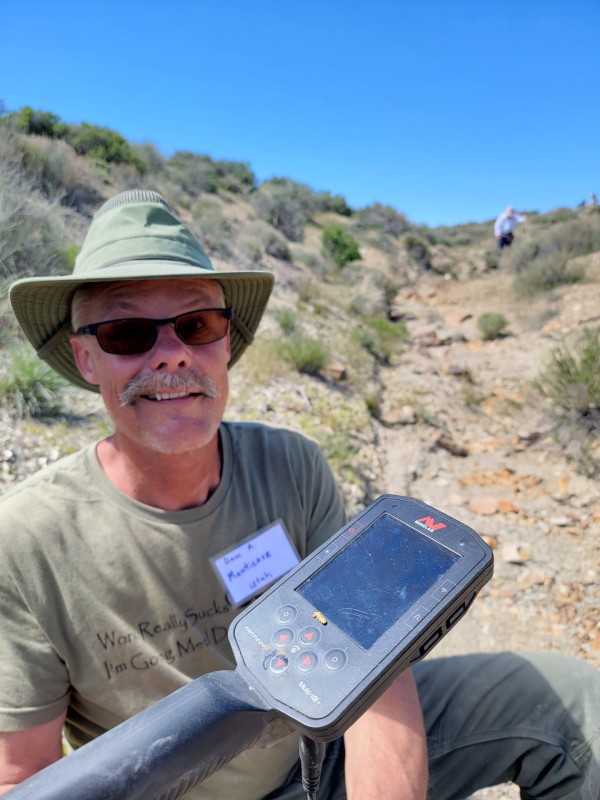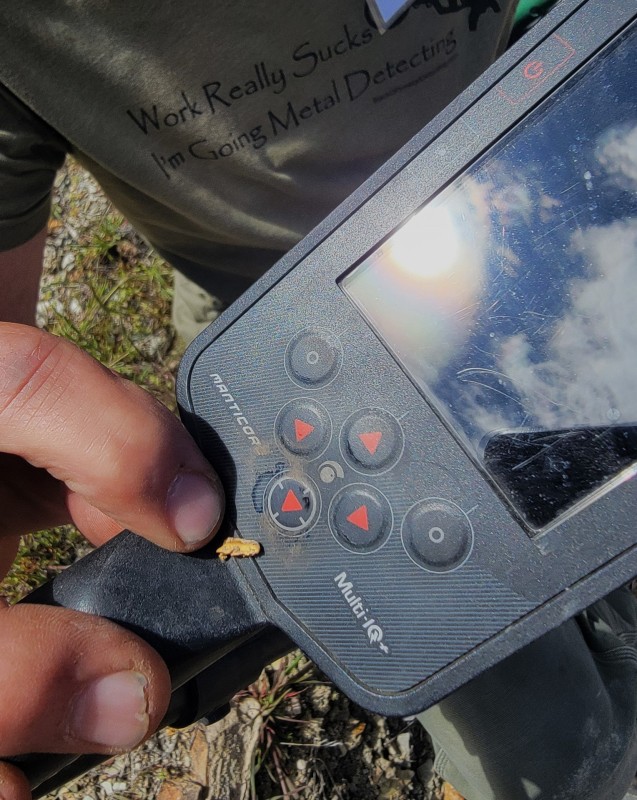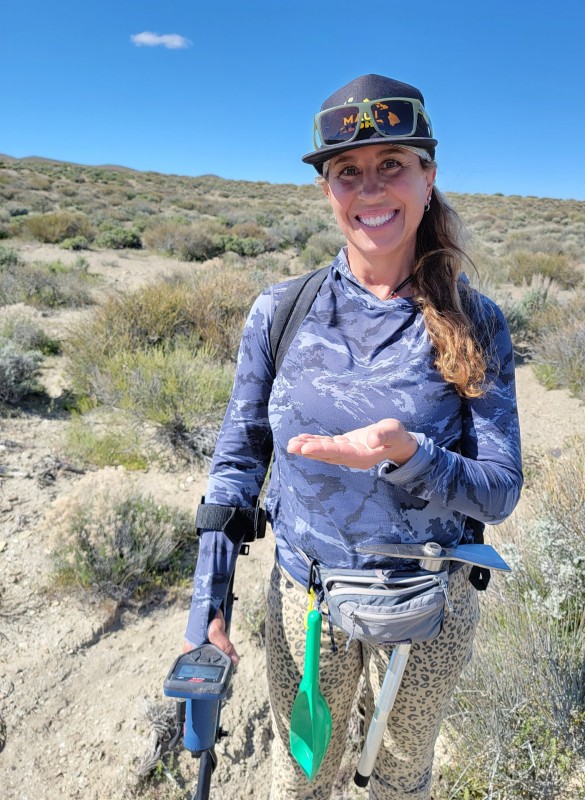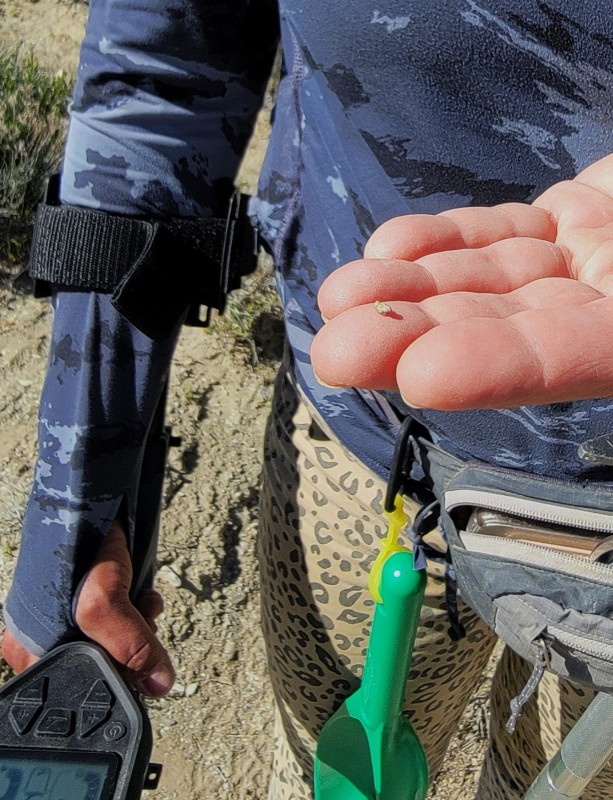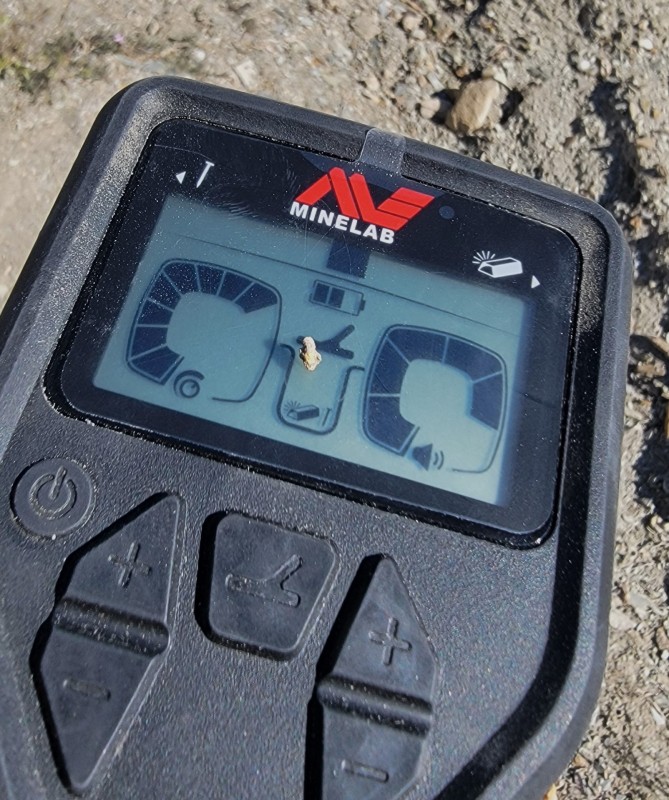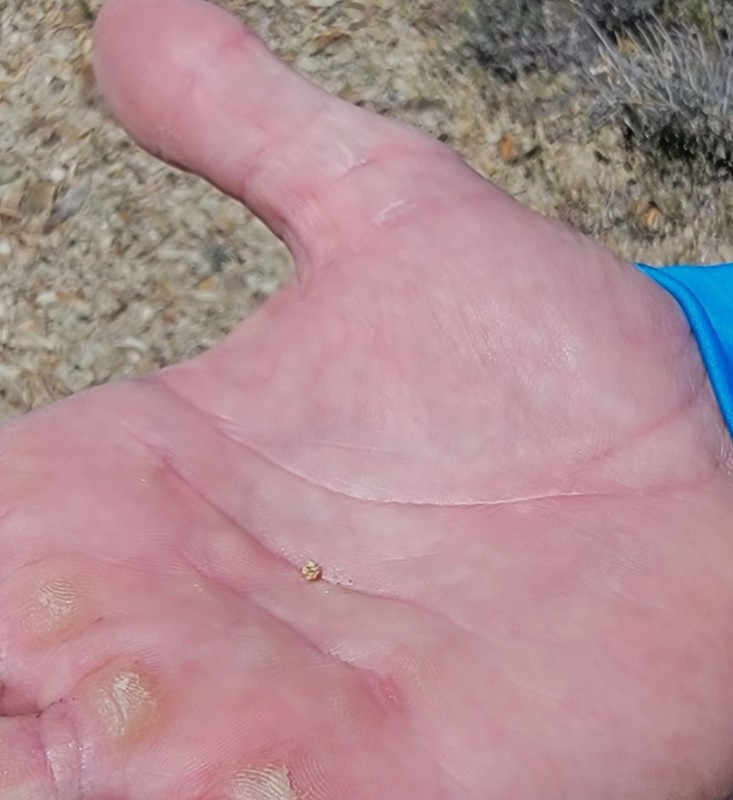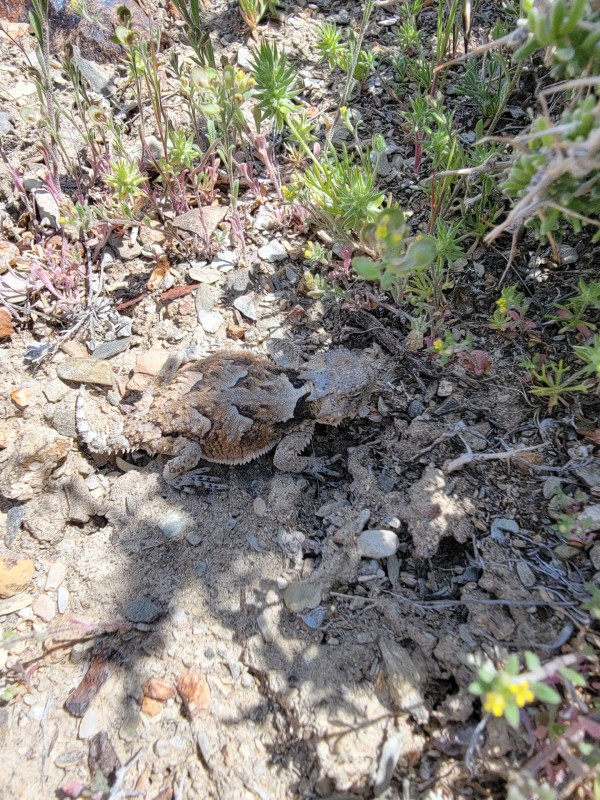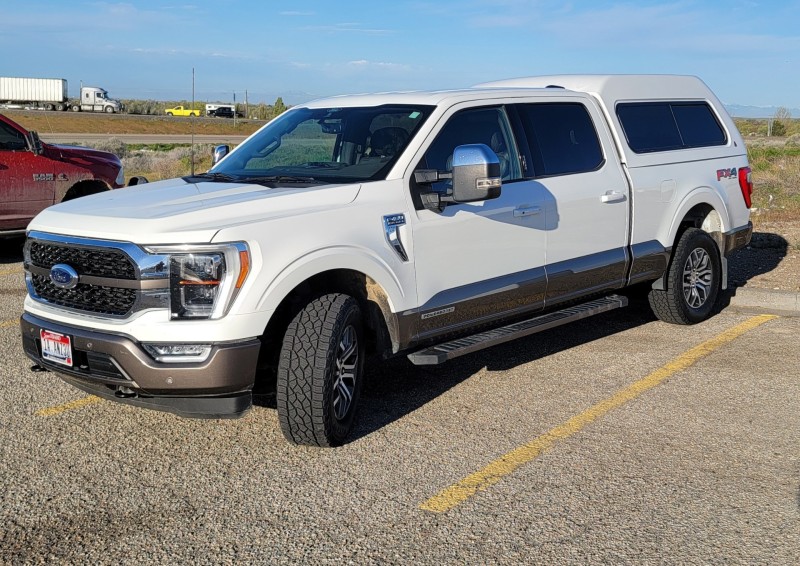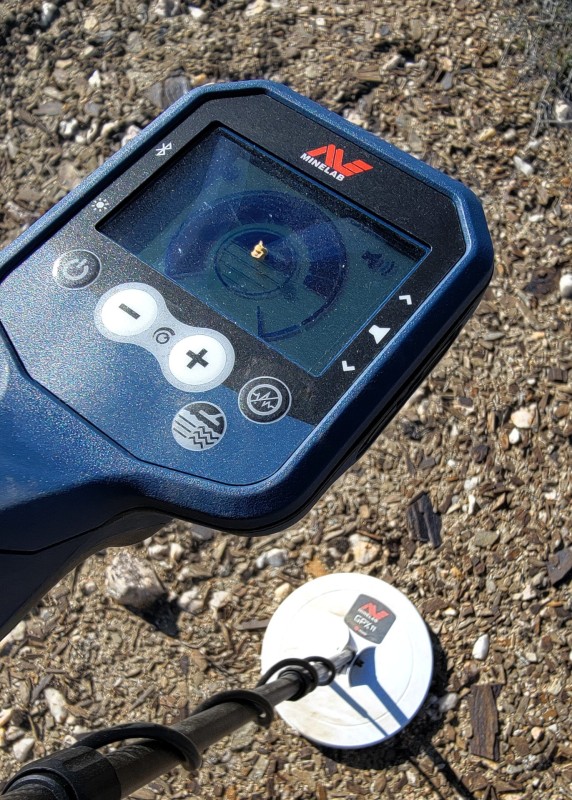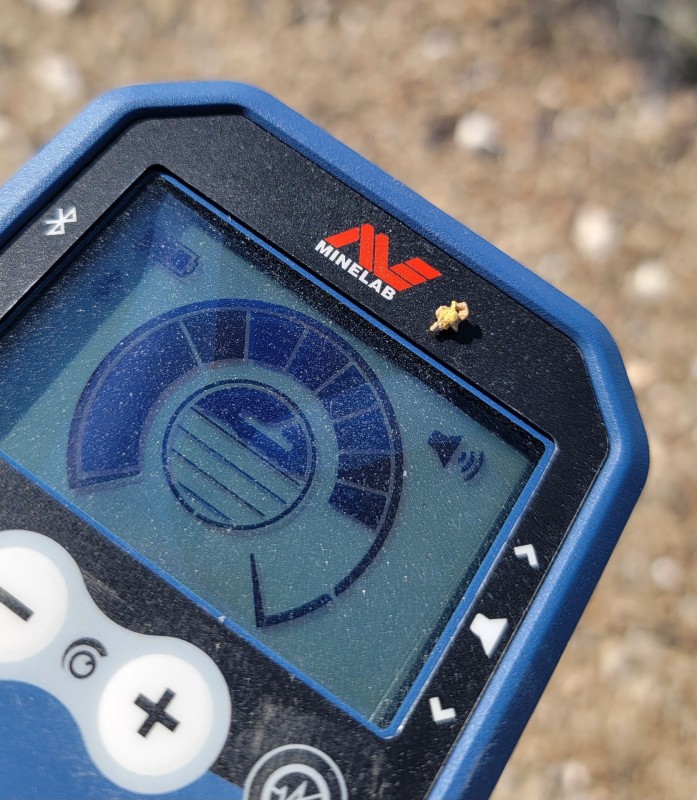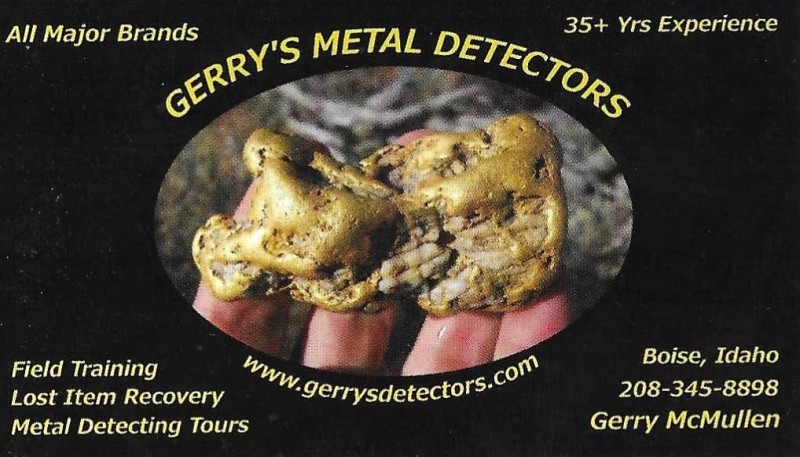Search the Community
Showing results for '"ground balance"'.
-
I'm surprised nobody has discussed the target ID hack on the Axiom, and if they have and I missed it, congrats for finding it and sorry for claiming fame to having discovering it! Many of you already know iron check grunts at most nuggets the size you really want >5g. I found the former undocumented "feature" because the latter "feature" couldn't be trusted. "Wait, WHAT!?" If you don't know iron check grunts at nuggets, it does. I won't get into it here. But target ID...This could be a common thing with PI detectors. I haven't had my hands on enough to know. But I have watched a lot of videos of people detecting nuggets, and not one have I heard mention this with any machine. I traditionally dug every single target. But as I've been scouting new ranches to guide on, I have had to work fast and use my time wisely. I can't spend months poking around a property to determine if it is viable. Turn on ground tracking, medium or fast mode is fine. I prefer medium to get a better reading of a section of ground under my sweep without taking too much time. I find in most ground in Sierra Nevada's foothills, the Axiom's balance window really likes to settle around 42/20, give or take. And if you place a small piece of gold on the ground, settings appropriate not to overload, and sweep it, you'll see that ground window shift to around 42-44/20-22, if it wasn't already there. Now, toss down a small piece of iron. This is dependent on conditions, but your ground balance window will drop to 20s-low 30s over as little as <10. Usually a strong iron signal is <33/18 before I walk away or dig it anyways. But depending on the ground, the size/decay of iron, the iron window, and depth, the window may also move UP to 50/30, or with small iron targets like rusted out wire, even tighten up at 70/50 (Brass does the same). Natural gold, in my experience with a lot of different pieces, will always pull the balance window as close to 42/22 as the conditions allow. I spent an entire day testing this out in some really tough ground that had everything in it to make your life miserable. I was digging iron wires the size of one of my trimmed beard hairs all day and was testing each new section of ground with one of my vials with a test nugget in it. We ended that day with a bang. A sore back and $1,200 in gold. I have not tested this with the mono coil. Only the DD-FC coils. It's important to note this isn't a hard number, or hard range you're looking for. You need to bring some gold, iron, and brass with you and every so often, if you find yourself working an area that is a bit trashy but you know has gold, use the test targets and find the baseline range for each. Also take mental notes of the range of each target before you dig it, and connect that range with the type of target. Of course, lead also likes that same window as gold. Sorry, keep collecting those bullets.
-

New Affordable Multi-iq Machine Coming In June
EL NINO77 replied to ☠ Cipher's topic in Minelab Metal Detectors
It is logical that minelab wants to fill a place in its line of detectors, and put on the market a detector that is somewhere between the X-Terra Pro detector and the Equinox 600/700, 800/900 family of detectors. One thing must be said here... that Minelab did not hurry and wait for what the competition will put on the market in this price segment... So I'm expecting a Vanquish class entry, but I feel that the new multi-frequency detector will already have a ground balance... -
New Affordable Multi-iq Machine Coming In June
phrunt replied to ☠ Cipher's topic in Minelab Metal Detectors
Noktas keeping them on their toes. No doubt it will have ground balance and be better than the Vanquish for design too. I love competition. Next will be the lower priced PI to compete with the Algoforce and Nokta PI. -

The Tesoro Detectors Are Crushing On Ebay
Jeff McClendon replied to George Kinsey's topic in Compass, D-Tex, Tesoro, Etc.
Honestly, I hunt like the video demonstrated for days on end whether it is at a "ghost town" site like the one in the video or even just hunting on some of the park sites in my area. Granted, I did have the recovery speed a little higher at that site than I normally use on less nail polluted sites which does shorten the length of the audio response. So for me, it's not just about the digital versus hybrid versus analog audio. It's more about can these Tesoro like detectors actually hunt some of the sites I go to? At sites like that where there are thousands of nails, unknown hundreds of thousands of hot rocks which VLFs will give a response on and ground mineralization from magnetite that is off the scale, if I choose to use a VLF, it has to have really good simultaneous multi frequency operation in order to have half of chance at determining that there is actually a non ferrous target under the coil, way before any audio response. Otherwise, a single frequency detector no matter how good it is will just call that zinc sitting on or near the surface as mostly or totally an iron target. That was the issue that I had using the Lobo Super Traq and Vaquero at that site along with many other single frequency detectors. The Tesoro's discrimination circuitry simply could not function at that site due to being next to impossible to ground balance on the magnetite mineralization and the amounts of iron trash. Many other single frequency multi tone capable detectors would call coin sized and smaller surface non-ferrous targets iron due to similar poor ground handling or just give an overload response even with their coils lifted off the ground. This is why I would be very interested in an SMF Deep Tech. -
White's Electronics Visit And A New V3i
Knomad replied to Steve Herschbach's topic in White's Metal Detectors
I think every major detector has its certain features a person could miss, I do wish the Nox and Manticore series had the display of the V3I, but hey the BFO detectors I built in the late 60s from Transistor Radio parts didn't need no stinking ground balance, you just tuned it constantly as you went, and they pinpointed better than actual pinpointers do today , with a Geiger Counter type tick that increased in speed the closer to a target. Thanks for the memories Steve. -

Original Gold Bug Instructions Video
Steve Herschbach replied to Lucky redd's topic in Metal Detector Advice & Comparisons
When you say original Gold Bug do you mean the 1990 analog model or the first digital version? The link to the manual for the original Gold Bug (analog) is in the post above and is where you need to start. The only Fisher video about the model simply showed how to put it together and not worth watching even if you could find it. The machine was one of several featured in an old VHS video Gold Nugget Prospecting : Metal Detecting With The Pros* but never made it to DVD or YouTube as far as I know. You best bet is the book Advanced Nugget Hunting With the Fisher Gold Bug Metal Detector by Pieter Heydelaar & Dave Johnson is an excellent primer on the use of the original Gold Bug model, linked below. There is not much to tune. Put it in Motion Mode. Turn Volume and Sensitivity to max. Set Threshold for a barely audible buzz. Ground balance properly (see manual). *Gold Nugget Prospecting: Metal Detecting with the Pros Authors: Ronald W Driscoll; Kathleen Driscoll; Brent Reason; Graham Alcock; Larry Sallee Publisher: Westwood Production Co. Prescott, AZ © 1994 Summary: You'll learn detector set up, basic research, dealing with hot rocks, types of ground to look for, where to go, coil control, patch gridding, implements needed, and view a small commercial operation using a metal detector. Featuring Larry Sallee, author of the book Zip Zip: Mastering Your Nugget Detector showing how to detect with the White's Goldmaster II, Bob Gutowski a.k.a. Nugget Bob with his Fisher Gold Bug, Floyd Allen a.k.a. Frugal Floyd with his Minelab XT 17000, and Glen Anderson with his Tesoro Lobo. All filmed in the field in Arizona. -
Nokta Detectors The Legend Software Update - Version 1.15 Updates Made: 1. Deep Target Identification (dt) feature has been added. This feature allows non-ferrous deep targets, which are masked or detected as iron (ferrous), to be detected as non-ferrous. To access this feature, select the Recovery Speed setting and press the pinpoint button. When you navigate with the right and left keys, the letters "dt" will appear on the right side of the screen. You can change the value of the dt setting between 1-6 by using the plus (+) and minus (-) buttons. When it is at 0, this feature is off. When you increase the value, the stability of the device may diminish. This feature can be used in all modes with both multi-frequency and single frequencies. 2. Beast mode has been added. Very deep targets may have values close to the surrounding soil and therefore may not be detected. Beast mode allows you to detect targets at depths that cannot be detected in other modes. This mode resets the ground balanced soil, allowing deep coins and large masses to be detected by the detector. However, in this mode, targets at fringe depths may not give an ID or their ID may be unstable. When switching to Beast mode, All Metal discrimination pattern will be selected automatically. When switching from Beast mode back to Gold Field mode, the last selected discrimination pattern in Gold Field Mode will be restored. To use this feature, simply press the frequency key in Gold Field mode. Beast mode is indicated on the screen by the letters ‘’bE’’ under the multi frequency symbol M. 3. Second ground balance feature added in Beast mode. Due to its configuration, Beast mode may cause the device to give false signals to ground changes and mineralized/hot rocks. This may cause discomfort to the user during detection. Beast mode offers users a 2nd ground balance feature to overcome mineralized/hot rocks, red bricks and other ground changes in the surrounding environment that have different properties than the soil that’s been ground balanced. With the second ground balance, depending on the properties of the hot rock or brick, in some cases, complete silence can be achieved over these falsing targets. In other cases, a broken signal may be heard. Broken sounds indicate that the detected target is a mineralized/hot rock. To use this feature, press the Ground Balance button to access the setting. Then, activate the 2nd ground balance feature by pressing the Frequency button. When the 2nd ground balance is activated, the number "2" appears on the screen above the letters Gb. You can perform the 2nd ground balance by pressing the pinpoint button. When Beast mode is selected, 1st and 2nd ground balancing can only be performed automatically. Manual ground balancing is not possible. You can switch from the 2nd ground balance to the first one by pressing the Frequency button again. 4. Ability to reset the 1st and 2nd ground balance settings in the Beast mode. While Beast mode is selected, the ground balance value is reset by entering the ground balance menu and long pressing the up button. When the button is held down, the animation is shown on the screen. To reset the 2nd ground balance value, first activate the 2nd ground balance. Reset the 2nd ground balance value by pressing the up button again. 5. Updates have been made in the Ground Balance Menu. a. When selecting between FerroCheck (FC) and Mineralization Indicator (GI), the 'FC' or 'GI' indicators displayed on the right side of the screen have been moved to the left. b. The 'FC' or 'GI' indicators which remain on the screen until exiting the menu will be automatically cleared from the screen after 2 seconds. c. When the Tracking feature is activated, the ground balance level flashes on the screen. In Beast mode, when the Ground Balance 2 is activated while the tracking feature is on, the ground balance level will be shown steady to avoid confusion. 6. "Iron Rejection" feature in Beast mode. Beast mode, like the Gold Field mode, produces signals for both non-ferrous and ferrous targets by changing the frequency of the sound according to the strength of the received signal. In order to distinguish ferrous targets, especially those closer to the surface, depending on the signal strength received from the ferrous target, the device emits a lower tone than that of the non-ferrous targets with the frequency varying according to the strength of the signal. To access this feature, select the Recovery Speed setting and press the pinpoint button. The letters "Ir" will appear on the right side of the screen. You can change the value of the ‘’Ir’’ setting between 1-5 by using the plus (+) and minus (-) keys. When it is at 0, this feature is off. When the value is increased, the probability of emitting a ferrous tone for deep non-ferrous targets increases. 7. General improvements have been made. Visit Software Update at noktadetectors.com: https://www.noktadetectors.com/metal-detector/the-legend/
-
Below are the results from a couple of days pulling apart mullock piles using the Manticore with the M8 coil . For the likes of Reg etc. I will preface this post by declaring I am in no way a prospector and have detected for gold probably less than 20 times in my life . And yes , my gold is certainly fly poop ! Of course I hope to stumble over a larger piece but meanwhile as a person who detects metals I find it utterly fascinating how small a gold piece the Manticore can find . I am using a version #1 machine that was one of the early machines into Australia . Gold mode , recovery 5 , sens 22-24 . Have experimented with tracking on and off finding that I cannot track out a small bit . Ground balance here is running between 40 to 54 . I am not using all metal mode . Gold is coming in at 6 to 9 in the sizes below . Hot rocks in the 20's and clearly in the non ferrous area on screen . Also 1 and 2 have so far proven to be rubbish . Signals on gold have been very clear and easy to call as gold , except for small lead . The area I am hunting has very high E.M.I. which drives my Nox nuts , but silent running here for the Manticore . The only drawback is coil knock sensitivity so requires good coil management , ditto for the Nox . Two days hunting with the second day being with two mates using their 6000's , they found nothing ! I have to say I have no wish to find gold any smaller unless it's in a pan . The Nox with a 6" coil may be superior on bits below .04 gram but above that I believe the Manticore is well in front . Sorry about the quality of the pics . I have no macro function on my camera and feel rather jealous of some of the pics on the forum .
-
The question, does it need another update, I think I am still in the yes category. Beaver tails are running from 19 to 28 maybe it's like that for everyone ? If your in an old park passing up beaver tails means loosing any chance of 1 dollar gold and nickels. Its also amazed at the range of memorial copper pennies, mine are running as high as 85-89. I have also found a ground balance issue (while using the M8) that I have not heard discussed, let me know if I missed a thread at some point. Oh and the depth indicator, mine usually shows maxed out on a 6 inch penny or dime ? Four arrows with a 4 or 5 inch coin? My ground balance is often under 10 that is mild right?
-
I’ve heard in non-variable ground of highly concentrated iron that the GPX-5000 specific ground balance has a slower tracking speed and will help get a better ground balance, but I will have to try this out when I get back to Gold Beach and see if it handles the iron any better especially with a DD coil. Anyone tried using specific in these iron enriched environments with any success on the 5000?
-
Nice reporting Mitchel, now find a ring! The target id is not ferrous versus non-ferrous. It’s a PI not a VLF. It’s more about small or low conductive targets read low numbers and large items or high conductors read high. Small ferrous reads low and in general the larger it gets the higher the number. So ferrous can occur anywhere on the scale depending on size. A big advance over existing PI options is that a coin will read with a repeat number as will other standard items. But don’t expect VLF rule ferrous vs non-ferrous discrimination. Some DD coils can work / detect items on the AlgoForce although only one half of the coil is active and results with the target id may be out the window compared to the mono coil. It’s tuned for mono coils. But noting what numbers a particular coil produces on standard items will still be helpful. Interesting a DD worked so well for you since only half the coil was working. You might want to confirm that as the info is minimal about DD coil operation on the E1500. As far as depth the E1500 falls above Infinium level performance and slightly below Axiom level performance as I explained previously here. Close to Axiom on small stuff falling farther behind a larger stuff, more in the same ballpark as ATX. It will beat a TDI that has ground balance engaged but if you turn off the ground balance on the TDI it will be another story.
-
The Tesoro Detectors Are Crushing On Ebay
DSMITH replied to George Kinsey's topic in Compass, D-Tex, Tesoro, Etc.
I think you are missing what I am saying when I say Digital I mean these detectors on a stick like the Legend and the Nox series detectors and several others with inaccurate target IDs and things like that, maybe i am stating it incorrect, don't really know All I can tell you is the detectors I am referring to, have no computer screen with confusing settings to set up, you ground balance set your disc to what you want to disc out and start detecting, for me personally they have made detecting fun again and for me personally that is what detecting is supposed to be (FUN), for me personally you should not need a degree in setting up a dang computer (Detector), for the ground you are detecting. -
ATX or for the worst of the worst, Infinium. VLF is no good in that stuff. A high power PI will blow back on you. The key is having both ground balance and a pulse delay. The ATX and Infinium both have a pulse delay control although Garrett marks it as a discrimination control. I picked up a used Infinium last year because I can get it to work on almost pure magnetite running a 10x14 mono coil, a feat most other PI detectors like my Axiom fail at. The secret ironically is the Infinium is not overpowered, and simply advancing the pulse delay until it is stable is the main tuning method. A DD may be needed. You will of course not hit small gold items and depth will be somewhat limited, but you will be able to detect. I get ring and coin type targets exceeding 12". If not, then the ground is simply undetectable, and yes, there is such a thing. If magnetite content is high enough it is like trying to detect through an iron plate. Where I’m detecting. This is not black colored sand but magnetite, same stuff you are dealing with. I've seen people confuse black colored material derived from slates, shales, or other dark materials with true magnetic black sands but they are not the same thing. Pure magnetite often has a gun metal blue sort of look to it. The easiest way for the uninitiated to know is simply drop a magnet in the stuff. Non-ground balancing machines like the Sea Hunter or Impulse AQ can also be made to work if you advance the pulse delay far enough. TDI is a good possibility. My Infinium chestmount with 10x14 mono. I really, really like that coil, a real gem. The advanced pulse delay eliminates thin foils. Small surface targets like hair pins read on both edges of the coil, a double blip response, and I generally ignore surface stuff unless larger. Larger targets will read in the center of the coil where small targets only hit on the edges. I mainly look for mellow centered high tones. As a ground balancing PI the Infinium breaks targets into two classes, high tone and low tone. Low tones are generally high conductors like pennies, dimes, quarters. I normally skip those in favor of high tone low conductors - rings and nickels. The tones work to full depth. Long story short with tones and a good coil as close to discriminating PI as you can get.
-
skywatcher Way back in the 1980s I managed to work a similar patch with a Garrett Deepseekers ADS VLF detector. What I did was used the TR discrimination knob and tuned it to the black sand like normal method by TR knob and not the ground balance knob. This work good but had to dig every signal, and got a large number of Aus. coins from it that other could not work the spot.
-
If you are talking about a situation where VLF detectors can no longer work reliably on black sand... we are talking about a case where the concentration of magnetite in Black Sand exceeds the value of 30% or more... another thing is that even if some VLF detector is able to work with such a concentration of magnetism/ in the case of a reduction in RX gain, or the use of a coil that is less sensitive to the X signal/ ...according to my experience.. the range of the VLF detector will be severely limited.. If I were you, I would try a PI detector with ground balance, which has a timing setting... for example Garrett ATX, where another plus is its water resistance..., and another advantage is that you can also use coils from the PI Infinium detector/ which are of classic DD construction of various sizes/ and the detector is still waterproof... using the ground balance and timing settings of the PI detector will help you eliminate the signal from magnetite... as well as the salt signal on the beach... while still maintaining a good range and sensitivity to small targets... which is already a problem with VLF detectors in such conditions. ..
-
I've owned the Minelab Manticore since release and have owned the M8 coil since last Fall. I'm fairly new to using a metal detector for gold prospecting. But I've done it long enough and used a fair amount of different detectors (both PI and VLF) to recognize when something special comes along. For gold prospecting enthusiasts seeking a powerful tool to uncover gold nuggets, the Minelab Manticore equipped with the M8 coil stands out as a excellent choice. Slightly different from Multi IQ, the Minelab Manticore uses Multi-IQ+ technology. Similar to Multi IQ, Multi IQ+ simultaneously utilizes multiple frequencies, ranging from low to high, this technology is particularly advantageous in gold prospecting, where varying ground conditions and target sizes demand precision and adaptability. I'm not going to pretend I know what the difference is between Multi IQ and Multi IQ+ is, but there's definitely something different going on inside the Manticore vs the Equinox 800/900. I think one obvious advantage of Multi IQ+ is ground handling and the ability to separate targets from ground signal. Equipped with the M8 coil, the Minelab Manticore is finely tuned for gold prospecting in challenging terrains. The compact size of the coil allows for exceptional maneuverability in tight spaces, such as rocky crevices and densely vegetated areas where gold nuggets may hide. At the same time you have fairy good ground coverage with the M8 coil. Also, the M8's sensitivity allows a person to find even the smallest gold nuggets with confidence. One of the greatest challenges in gold prospecting is overcoming the effects of highly mineralized or alkaline soils, which can mask small gold nuggets and produce false signals. The Minelab Manticore offers a range of ground balancing options, including automatic, manual and tracking modes, allowing you to adapt to changing soil conditions and maintain maximum sensitivity to small gold nuggets. I'm not a big fan of tracking ground balance because I've experienced both small and deep targets being tracked out on previous metal detectors. However, with the Manticore I've had little issues with either of the above and use ground tracking with confidence. In the places I hunt, alkaline soil and hot rocks offer unique challenges for VLF metal detectors. Coil knock and constant ground noise are some of the most common. The Manticore is still challenged with coil knock, so coil control is essential when using it in rocky terrain. Ground noise on the other hand, the Manticore seems to handle quite well compared to the Equinox and other SMF detectors I've used in the past. With the Manticore ground noise is more of a background annoyance that's easily decerned from a gold nugget or other small target. Identifying gold targets amidst a sea of hot rocks and other metal objects is essential for successful prospecting. The Manticore offers precise target identification capabilities, thanks to its customizable discrimination settings, expanded target ID range and 2D target trace. By fine-tuning discrimination levels and analyzing both target ID and 2D screen readings, you can easily distinguish between hot rocks, ferrous and non-ferrous targets, prioritizing ferrous signals for efficient recovery. A person wouldn't think the 2D screen would be much use when gold nugget hunting. But on the contrary it's become one of my favorite features of the Manticore. Shallow targets generally trace right on the center line, deeper targets trace just above the lower ferrous limits or just below the upper ferrous limits depending on depth and soil mineralization. The expanded target ID range is another welcome improvement over the Equinox 800. With the 800 most small gold had a target ID of 1 or 2 which also encompassed small foil and other tiny non ferrous targets. The Manticore on the other hand with it's expanded target ID range makes it easier to decern between small gold and other unwanted small items such as foil and small bird shot. That being said I've had nuggets under .20 grams come in anywhere from 1-9 so you still need to be carful. But with an area loaded with an item such as small foil that generally ID's at 1-2, you can cherry pick to some extent and still find small nuggets. I've really enjoyed the Manticore the 100 or so hours I've had it out gold prospecting and feel like it's the perfect companion to your favorite PI. The settings on the Manticore I start out with when I get to a site are: Gold prospecting mode, prospecting theme, sensitivity 19, recovery 6, stock ferrous limits, stock disc pattern (horseshoe off), ground balance tracking. I then make adjustments when necessary which can include raising/lowering sensitivity, raising/lowing recovery, using fixed ground balance, notching out hot rocks or running the horseshoe on. Below are a few videos I've done using the Manticore gold prospecting. Enjoy
-

Sampling For Mineralization With The Axiom Ground Balance Window
JCR replied to timbus59's topic in Detector Prospector Forum
I don't think there is any difference between a VLF & PI detector, but on a VLF, Ground Balance numbers do not indicate the level of mineralization. It indicates the general type & conductivity of the ground. With that said, your idea may be valid, the same as using GB #s to trace Black Sand deposits. But this has more to do with Specific Gravity in an undisturbed setting. Rock piles would be much more random. The older analog VLFs that had an analog meter often had a Calibration point to differentiate between Mineral vs Metallic. This feature was used to sample ore to determine it's potential content. You would think modern digital machine could/would offer this same feature for ore sampling. -
I have a bank of bench gravels on my claim that is some distance from water, with precarious tailings piles in between. I'd like to take samples along the length of the bank, but I don't want to haul a bunch of heavy buckets across dangerous tailings piles to the water. Then I got this idea. If you open up the Axiom's ground balance window (press and hold the GB button until you get a double beep) and sweep it across a sample area of the bank (lets say 6' X 6") it should give you an average for the mineralization for that sample area. Then you repeat the process taking sample readings along the length of the bank. The most mineralized areas (hottest) that have the highest GB window numbers, may be most likely to contain more gold. I'd then haul buckets from just the hottest areas, reducing my chances of breaking a leg. 🙂 Does the idea of using the GB window to pick the best samples from the most mineralized ground seem sound?
-
I probably won't use the F19 for gold, although upon firing it up and trying it out with the Nel Snake I must say the 19kHz Fishers have always been pretty impressive and it's easy to forget after having the Bugs in the cupboard for a few years, detectors like the GB2 and Equinox 800 will hit smaller gold, but how small is too small? For me I love finding the tiny stuff for the challenge of it all, it virtually has no value so it's not something everyone would waste their time doing, I'm never bothered about that, none of my gold has value as it's never getting sold. They like our milder NZ soil too, and get pretty good depth on nuggets, Justin at the gold shop in Arrowtown talked highly of his time using Gold Bug's right from the first one and the masses of gold he found with them. We have the advantage here of not having to worry about ground balance, the Bug hits the ground running and just works so losing performance due to the ground isn't such an issue. The key to the 19kHz detectors from FT and small gold performance is the threshold, it has a sweet spot, too high and you lose performance, too low and you lose performance, you have to get it just right, you quickly learn with air testing the just right position so it's not a challenge to work it out, but it's a necessity to get it right for best results. Something we will never know is if gold we found with one model detector would have been found with another, I think I'd do alright with the F19 on gold and doubt I'd miss much that I'd find with the Nox or GM1000.
-

F19 Vs Gold Bug Pro
GB_Amateur replied to phrunt's topic in First Texas - Bounty Hunter, Fisher & Teknetics
In an air test at max sensitivity, my GP Pro stock w/5"DD coil in Discriminate Mode (All Metal mode doesn't show digital target ID but rather ground balance setting) gave dTID readings in low 90's for USA 90% silver dollar, 1 ozt 99.9% silver round, and 1 ozt 99.9% silver rectangular bar. I stacked those three on top of each other and it still read in the low-mid 90's. That's one sweet detector that's so easy to set up. It doesn't have quite the depth of the modern multifrequers, nor features like noise cancelling that many detectors have. But for turn-on-and-go-find it's a workhorse, and the coil availability is also excellent. -
F19 Vs Gold Bug Pro
phrunt replied to phrunt's topic in First Texas - Bounty Hunter, Fisher & Teknetics
I just found discussion on the GBP firmware versions indicating what has changed between some versions on Dankowski detectors forum by our very own Steve, so I'm sure he won't mind me putting his post here. The rest of the thread is also a very interesting read for those interested in the FT 19kHz machines. "The late 1980s Fisher Gold Bug was a real design breakthrough at the time with S rod, elliptical coil, and compact detachable control box. It ran at 19 kHz which was high at the time. There was no discrimination at all. Just beep and dig. It is a very good detector but the lack of ferrous discrimination would be a major lack compared to the current crop of detectors. The 1990s Gold Bug 2 looks physically the same, but upped the frequency to 71 kHz making this an extremely hot unit on tiny gold. The trade off is it actually gets less depth on large gold in mineralized soil than the earlier 1980s Gold Bug. The addition of a very good iron discrimination setting is a major plus, and the model is still produced today. As a prospector I consider it a "must have" detector due to the extreme sensitivity to small gold. The Gold Bug 2 can be purchased new with either a 5" x 10" concentric coil or 4" x 6" concentric coil for the same price. There are no DD coils for the unit. The only other coil option is a 14" elliptical coil. First Texas then decided to produce a huge number of variants on a new design. The new 21st century Gold Bug is sold as the Gold Bug, the short lived Gold Bug Special Edition, the Gold Bug Pro, and to really make life interesting, the Teknetics G2. These are all 19 kHz detectors with digital target id and adjustable audio discrimination. The Fisher units have a S rod design with control box mounted on the rod and the Teknetics units have a pistol grip design with the control box mounted on top of the pistol grip. The Gold Bug Pro comes with a 5" round DD coil and the Gold Bug Pro DP is just another variant in that it is the same detector but standard with the 11" elliptical DD coil. The G2 comes with the 11" elliptical DD. Units with the 11" DD cost $50 more than units with the 5" DD. The new Gold Bug, Gold Bug Special Edition, and Gold Bug Pro all also have firmware variants which generally change the audio output in small ways most people would not notice but which detector nerds like myself obsess over. Modulated audio or not? VCO or not? There was also some concern about lack of sensitivity to silver coins at one point supposedly addressed by later firmware variations. Regardless silver is not a strong point on the Gold Bugs which, well, are designed to find gold. I believe we are up to version 4 of the firmware, with version 3.0 and 2.9 Being a couple earlier versions. With the unit turned off and set in disc mode, depress the ground balance button. Keep holding it depressed, and turn on the detector. The firmware version should display. My Gold Bug Pro displays version 3. If buying new I think you can pretty much ignore the firmware issue. If you like S rods, go Gold Bug, and decide which coil you want to get with it as the stock coil, 5" or 11" (or both). If you want pistol grip then go G2 but as far as I know you can only get that with the 11" coil as stock. Just to make matters interestingI will mention that the new 5" x10" DD accessory coil is getting nods as perhaps the best all around coil for the unit. Mine is on order so I will have to weigh in later on that. For prospecting I would lean towards getting the Gold Bug Pro with 5" coil and adding the 5" x 10" accessory coil if you want a larger coil. Hope this helps, Steve Herschbach" So, there we go, I wonder if they ever went past version 4 on the Bug, if anyone has one that is a recent purchase it would be cool to see if you have a newer firmware than my version 4. I assume the version 3 I have on my F19 is the latest, but with the F19 being a newer detector I'm surprised they're up to version 3 on it unless the Gold Bug is now up to version 6 or something. I think the silver coin problem was fixed with a POT adjustment, not a firmware update, as demonstrated by my Gold Bug Pro's. This seems to be verified by Keith in a post under Steve's on that forum. I'm also wondering if Fisher wind down the sensitivity on detectors like the Bounty Hunter Time Ranger Pro so the more expensive models of the same detector perform better, this would be simple for them to do and encourage people to buy the higher priced models seeing they're the same detector, I would not be at all surprised. So, if anyone has a Time Ranger Pro, please check the firmware version too, that might be interesting. I am betting they do. I guess the only way to know would be side by side testing like I've now done with my GBP's and F19 with the F19 having higher gain than my old model GBP's. I think the Bounty Hunter will have a lower gain making it more suitable as a beginner's detector with the target brand and price range. -
What an amazing group of eager customers we had on the 3 Days Field Training. The weather could not have been any better with temps in the 70's. Friday was so sunny many of us ended up with red face and a few days later peeling skins from the sunburn. Soil was still very damp and in fact some standing water in mud puddles on the way up to camp. My Field staff/I enjoyed a variety of detectors in the class. Gold Bug-2's, Gold Monster 1000, Equinox 800, Equinox 900, Manticores, GPX-6000's and a GPZ-7000. 1st day was mostly classroom and as soon as the students with a variety of backgrounds were able to witness the varieties of gold and how they respond to different detectors, boy did they start getting excited. As expected, the GB-2's coils respond to the tiniest of gold best, but as soon as you went to a small picker nugget, the Monster, Equinox and Manticore took over. Then it was seeing how the bigger 6000's & 7000 did on small, medium and large gold. It's amazing that everyone talks the depth of a PI or GPZ but how many of you have actually seen with your own eyes, one of those detectors respond on big gold at 2 feet, 3 feet and even 4'? Yes that's what we did one a couple big ones. Some people had no clue and wondered out-loud, if they could even dig a hole that deep??? Realize this was just an air test, but it's still impressive. Of the 12 customers, most found a piece of gold and a couple folks doubled down. I know 3 of them just quite didn't get that lucky but they tried hard and there is not much we can do about that. The good thing is they were able to find small foil and #8 bird-shots, so we know they are doing it right. No big gold was recovered as expected, but I know there still has to be a few chunky 1/4 oz'ers out there. I know a couple years back Arky's wife was running around with her 7 while he took the class with his 6 and she dug up an 8-gram solid chunk of Au. So yes, there are still a few but nothing like it used to be. A couple of the students mentioned that they had taken Ray Mills class (in CA) and was noticing such a difference. Ray knows Geology and so most of the 1-day class is dedicated to such. They realized this class is much more detailed on the detectors and how to get the most out of them. How to tell ground from a true target and importance of proper coil control. It's funny how I can toss a small nugget in front of a student and yet they can't find if, even though they just seen where it was tossed. At the end of the class, the students can find that same nugget and then some. That's just part of the reason our class is 3 days instead of 1. I totally agree with Mr Mills class as well and so if you desire more of the geology side, you might reach out to him. The main road along the lake was actually the best I have seen it in years. But those of you who know Rye Patch area (and Northern NV) know the rocks are treacherous on tires. There were 3 flats during training, 2 flats just after class and yes one guy had 2 flats, but I took home the cake. I had a slow leaking tire and was able to limp how, getting air at each little stop all the way to Idaho. Luckily my truck as tire pressure sensors and I can see exactly which tire and how low. The drivers front got down to as low as 22 pounds between air ups but still held until the next stop at Rome Station (they have a pump that uses quarters). Anyway, when I got to Boise and took it in, they pulled the tire and showed me a tear in the face that was to big to be repaired. To order the exact same tire and size, would take 3 days. Well, I knew those stock tires were only P rated (most 1/2 tons are), so I decided to get something more designed for my off-road travels. $1250 (after military discount) and I'm sporting some new heavier tires and better tread. I should have known that from many flat tires and years past. E rated 10 ply are some of the best for getting least flats, but they are expensive and heavy, so you lose fuel mileage as well. Moral of the story. If you are running around in N Nevada roads, you better have at least LT class tires or higher. Make sure you have at least 1 spare tire and the correct equipment to change it. I left my compact air compressor in my big truck, so dumb me on that part. Here's the truck with the new tread. Yes those of you running around that weekend did in fact see a semi truck driving out there. That lady has guts. UT Chris took advantage of the Anniversary Promo and $500 off. Gerry's Detectors hand delivered it to him right out there in the field. Below - Geno from NV using a GPX-6000 and CoilTek 14x9" GoldHawk coil finds gold. Below - Dave from UT shines a smile with his 1st NV gold using a Manticore and M8 coil. Below- UT Chris found the 1st nugget of the class early Saturday morning before we even got started that day. He scored it with a GPX-6000. Below - Geoff from NV was able to find a couple with his GPX-6000, here's his 1st. Below - Chris from Idaho started the class with a GB-2 but when he seen how the Identification System on the Equinox performed so much better than most other detectors, he traded up. Good for him for trading that last day, as he still was able to find his 1st gold. Below- Nancy the trucker is tough as nails. For someone of that age to be out there roughing it and go go go, with the never quit, it finally paid off with a little help from the Staff. She knows her Manticore can find small picker nuggets. Below- Dennis from CA was an interesting guy. His brother from Idaho took my class last year and so he knew exactly what to expect. We was happy as heck once he got the golden monkey off his back. He found it with his Equinox 900 and small 6" coil. He is also the same guy who ended up with 2 flat tires. Yes he drove a new F-150 with stock P rated tires. Below - Geno gets another RP nugget. This guy is getting the hang of it really well. Below - Horny toads were just starting to come out. We only seen one snake and it was at camp but not a rattler. Why do they call them Horny Toads? Below - Dave from UT find his 2nd nugget and it's pretty nice. He used the Manticore with M8 coil again. Did you catch the phrase on his shirt? My 1st piece of gold in 2024. No, it's not worth sticking in my mouth like some of my big dogs. It took all of 45 minutes to find right near the burn barrel. I used GPX-6000 with stock 11" coil. Below - Best looking nugget of the trip was Jill and her Gold Monster 1000. Again, The group of students was so enjoyable and upbeat. Geoff/Jill brought a box of smoky quartz crystals and told everyone to take a couple for good luck. Boy it must have helped as most folks found gold. What's more important to my Staff/I than customers finding gold. Customers understanding their detectors more, learning to tell the difference of a ground noise and a target, proper coil control, knowing when to ground balance and why, what machines do best on a variety of gold and most of all.... self confidence in your detector and abilities. Thanks Eli, Lunk and Spencer for your support again. I have already received a few emails on how happy the customers were with you guys. Anyone else wanting to take advantage of the Anniversary Sale and save $150 off the Equinox 900 or $500 off the Manticore..call Gerry's Detectors, as I have a few remaining. Also remember, those who purchase their detectors from me, get an additional discount of $150 off the 3 Days Field Training. You only pay for training when you show up. Happy Hunting. Gerry in Idaho
-
1.thumb.jpg.edb95f9e9ba2a593529806ae31899c40.jpg)
Troy X5 Review By Steve Herschbach
Suncoast Kid replied to Mark Gillespie's topic in Metal Detector Advice & Comparisons
I know someone who uses one in Arizona. I've never heard of anyone having an issue with hot ground, or ground balance, as it has a ten turn pot. His ground is as bad as it gets. The only complaint I heard was maybe with hot rocks. -
https://www.minelab.com/community/treasure-talk/specific-ground-balance-on-the-gpx-detectors I was curious if anyone uses the specific ground balance method with their 5000’s in areas with high iron content and uniform ground conditions that are hard to get a ground balance in Gen. ground balance. Attached is Phil Beck’s from Minelab’s write-up on it.
-
Well, it sure seems they are serious about going up against Minelab. It's hard to deny the fact they are being competitive with the pricing. For the price they have on the FindX($139), it is very appealing to new people just thinking about detecting. And the FindX Pro model for $179 adds waterproofing on the entire unit. They are including a stainless digger, wired headphones, AND a carrying bag.. Man that is insane. How are they even doing this? Spec-wise it isn't a bad machine at all. It lacks advanced feature manipulation but does include automatic and manual ground balance. A very simple turn on and go machine. 15khz frequency. Wonder how it will do? The only odd/weird thing I see is charging on the regular FindX. Someone would have to unscrew and remove the search coil to charge. That may be a problem or failure point over time. The FindX Pro is like the Legend for charging, meaning there is a separate port integrated for headphones also.



